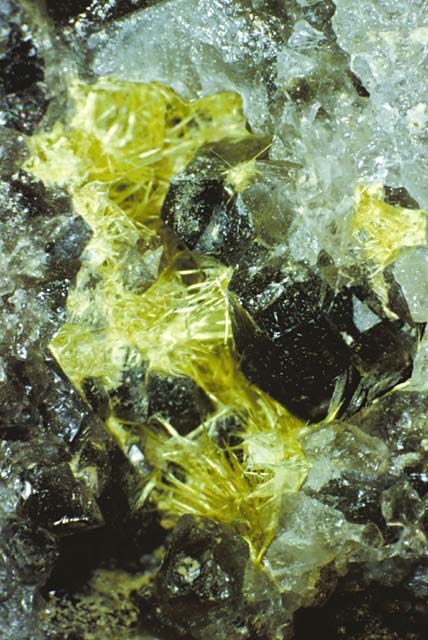Pictured here is an image of ferrimolybdite from Kingsgate, New South Wales, Australia; field of view, 1 cm. Photo by Jim Sharpe; Specimen, Lawrie Lawrence. Photo courtesty of the Australian Journal of Mineralogy.

|
A few years before the Civil War, geologist David Dale Owen of New Harmony, Indiana, published a "Notice of a New Mineral from California." The final sentence of his Notice closes with these words: "hence I infer that this mineral must be a submolybdate of iron." In modern listings of minerals, the only mineral whose description matches that of Owen is ferrimolybdite.
Pictured here is an image of ferrimolybdite from Kingsgate, New South Wales, Australia; field of view, 1 cm. Photo by Jim Sharpe; Specimen, Lawrie Lawrence. Photo courtesty of the Australian Journal of Mineralogy.
|

|
As Owen had already authored several paleontological species, it is tempting to compare the two types of taxonomy - biological and mineralogical. During the early nineteenth century, naturalists found and named thousands of new species of plants and animals, while, on a much smaller scale, geologists found and named new minerals. While there are millions of the former, there are fewer than 4000 minerals.
As you read Owen's account, you may detect a certain sense of satisfaction, inasmuch as three of the New Harmony scientists believe that they are establishing a new mineral, despite the opinion of an unnamed "distinguished mineralogist."
Owen's article, in Proceedings of the Academy of Natural Sciences of Philadelphia 6 (1852-3) 108-109, begins with a reference to Henry Pratten, whose collecting journey from New Harmony to California is described elsewhere (see the link to Henry Pratten at the bottom of this page):
Mr. Henry Pratten, one of my assistants in the geological surveys in the North West in 1848 and 1849, went to California in the spring of 1850, and returned last February. Being interested in mineralogy and geology, he made observations in these departments of science, both on his way out and during the time he remained there.Now, to answer the question about this rare mineral - was it new to science at the time that Owen published his article? The answer is no. On the other hand, Owen's article did contribute new information about the mineral.The mineral in question he obtained at a locality known as the Wisconsin and Illinois claim, near Nevada City, at which place he resided most of the time he remained in California.
At the time he collected this mineral it struck him as something remarkable and different from anything he had previously observed; and he made at the time some experiments on its blowpipe reactions, without being able positively to decide what it might be.
He then first submitted it to a distinguished mineralogist, who referred it to the species Karpholite.
In comparing its blowpipe reactions with that mineral, Mr. Pratten doubted the correctness of the conclusion that it belonged to the species Karpholite, and so did Dr. Norwood, who also examined its blowpipe reactions; and they came to the conclusion that its indications before the blowpipe resembled more those of Molybdic acid.
When I returned home last March, Mr. Pratten submitted it to me and I made a qualitative examination of the mineral in the humid way, and ascertained, from the reactions of the solution of the mineral with sulphuretted hydrogen, iodide of potassium, and ferro-cyanide of potassium, that the principal constituents were molybdenum and iron.
As early as 1800, the mineral had been described in European journals under various names, and it was given the name molybdite in 1858. In 1859, the Philadelphia chemist F. A. Genth published a note beginning with the words "I am indebted to Dr. D. D. Owen for some fragments of [Molybdate of Iron] from Nevada City, California, and have made a few experiments with the same, but regret that the rarity of this substance prevented a fuller examination." In 1907, W. T. Schaller wrote on the subject. His introductory summary is quoted here:
It is shown that the natural molybdic ocher, called molybdite, is not the trioxide of molybdenum, as stated in the literature, but a hydrous ferric molybdate with the formula, (Fe2O3).(3MoO3).(7.5)H20.Schaller mentioned the work of Owen and Genth but did not specifically credit Owen as the first to establish that ferric iron is an essential component.
Schaller writes, in conclusion, that "The existence of the trioxide of moylbdenum [MoO3] as a natural mineral has not been demonstrated, and what is commonly believed to be MoO3 is shown to be a hydrated ferric molybdate." He concludes that the name molybdite should be retained "until it is shown conclusively that an oxide of molybdenum does exist in nature."
Nevertheless, in 1914, Pilipenko introduced the name ferrimolybdite, giving a type locality in Siberia. It was not until 1963 that MoO3 was proved to exist in nature (in the Czech Republic) and the name molydbite was officially adopted for this oxide - so that it was no longer the name for the "new mineral from California."
Owen's article refers to an early edition of Dana's Mineralogy, a book which is still today widely regarded as the official catalogue of known minerals. References to the literature mentioned on this page are given in the 1951 and 1997 editions.